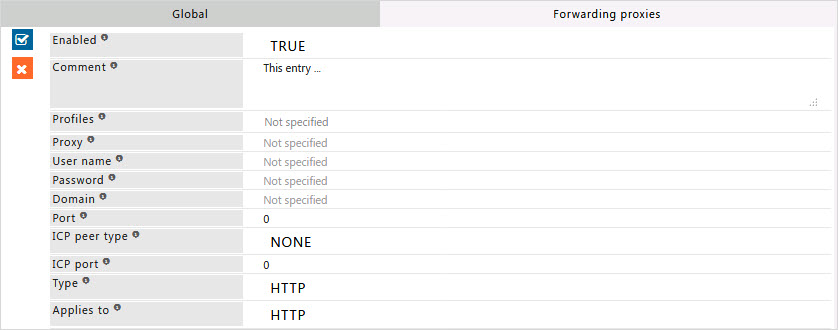Proxy chain
Overview
The Proxy chain section allows you to selectively forward requests through another proxy, SOCKS4 or SOCKS5 firewalls.
You can also use ICP (Internet Cache Protocol) and CARP (Cache Array Routing Protocols) to share cache with peer or sibling proxies.
CARP (Cache Array Routing Protocol)
The Cache Array Routing Protocol (CARP) is used in load-balancing HTTP requests across multiple proxy cache servers. It works by generating a hash for each URL requested. A different hash is generated for each URL and by splitting the hash namespace into equal (or unequal parts, if uneven load is intended) the overall number of requests can be distributed to multiple servers.
ICP (Internet Caching Protocol)
The Internet Cache Protocol (ICP) is a protocol used for coordinating web caches. Its purpose is to find out the most appropriate location to retrieve a requested object from in the situation where multiple caches are in use at a single site. The goal is to use the caches as efficiently as possible, and to minimize the number of remote requests to the originating server. Hierarchically, a queried cache can either be a parent, a child, a sibling.
Global

Enabled
Enable or Disable proxy chain section.
- TRUE : Enable proxy chain section.
- FALSE : Disable proxy chain section.
Enable CARP
CARP is a protocol used by a cluster of proxies to have them act as one logical cache by using a hash algorithm which combines the proxy's hostname and requested URL to determine which proxy server the URL is requested from, and thus cached on.
- TRUE : Enable CARP.
- FALSE : Disable CARP
CARP hash size
Specify the maximum value of the CARP hash; the lower the value, the greater the redundancy of cached files across peer proxies. Set to 0 for maximum size. Any value other than 0 breaks compatibility with Squid, and all peer proxies must use the same size hash.
Forwarding proxies
List of proxy servers to forward connections to.
Enabled
Enable or Disable this entry.
- TRUE : Enable this entry.
- FALSE : Disable this entry.
Comment
For documentation, and future references, explainthe relevance of this entry with your policies.
Profiles
Specify the Profiles applicable for this entry.
This entry will be applicable only if the connection has any one of the specified profiles.
Leave it Blank, to apply for all connections irrespective of any applied profile.
To avoid application to a connection that has a profile, use negated profile (!profile).
Proxy
Specify the hostname or IP address of the proxy to forward through.
If this field is left blank, and the host or file options aren't, no action is taken for requests matching the host and file.
If the Proxy is the same as the server's own hostname, the entry is ignored.
This makes it easier to have a configuration file shared between several proxy servers.
User name
Specify the user name to use if the proxy requires authentication.
Password
Specify the password to use if the proxy requires authentication.
Domain
Specify the NT domain when using the NTLM authentication protocol.
Port
Specify the port number of the proxy to forward through.
ICP peer type
The peering relationship of this proxy.
- NONE : The ICP protocol will not be used with this proxy.
- PARENT : This proxy is a Parent. When no peer has the cached file, it will still be requested from a parent, so that it is cached for other peer proxy servers.
- SIBLING : This proxy is a Sibling. Files are requested from it only when it has a cached copy.
ICP port
Specify the UDP port ICP packets are sent to.
Type
Specify the type of the proxy; can be HTTP, SOCKS4, SOCKS5 or CONNECT.
- HTTP : This is a HTTP proxy.
- SOCKS4 : This is a SOCKS4 firewall.
- SOCKS5 : This is a SOCKS5 firewall.
- CONNECT : The connect method will be used through the HTTP proxy.
Applies to
Specify the type of requests that are forwarded through the proxy; can be HTTP, FTP,SOCKS5 and/or CONNECT (HTTPS).
- HTTP : This proxy will be used for HTTP requests.
- FTP : This proxy will be used for FTP requests.
- CONNECT : This proxy will be used for CONNECT requests.
Example
Rule#1
I want to forward all my request to proxy server 192.168.2.179 and port 8080.
ICP peer type is set to be none
Type of proxy is set to be connect
And for request type of HTTP FTP and connect

